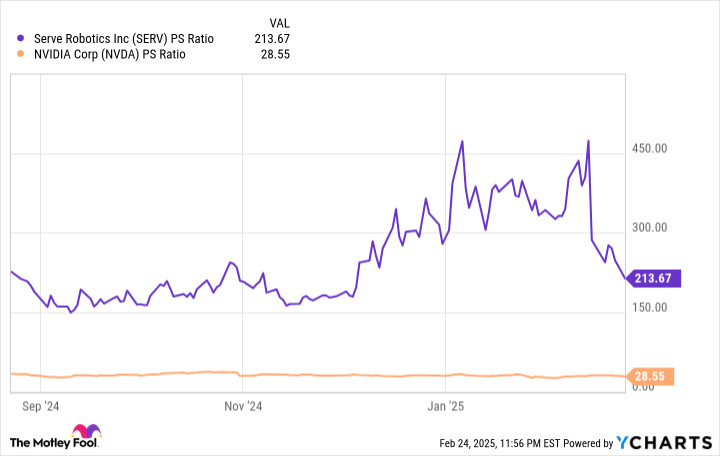Ride-hailing giant Uber Technologies and AI chip powerhouse Nvidia were once key investors in Serve Robotics (SERV). However, recent news revealed that Nvidia divested its entire stake in Serve Robotics at the close of 2024. This development triggered a significant drop in Serve stock, plummeting over 50%.
Serve Robotics specializes in autonomous last-mile delivery robots, utilizing Nvidia’s technology. They are in the process of deploying thousands of these robots through a partnership with Uber Eats. As Serve Robotics prepares to release its Q4 2024 financial results on March 6, investors are keen to understand the company’s progress and future prospects.
Could the sharp decline in Serve stock present a potential buying opportunity as we await the financial report?
The Potential of Autonomous Last-Mile Delivery
Serve Robotics argues that traditional food delivery models are inefficient due to their reliance on human drivers and vehicles, both representing substantial costs. The company champions autonomous robots and drones as a more economical solution for last-mile delivery, especially for smaller payloads. They believe the decreasing costs of AI hardware and software further enhance the viability of their approach.
Serve Robotics has developed robots with Level 4 autonomy, enabling them to navigate sidewalks independently within designated areas. Impressively, these robots have already completed over 50,000 deliveries for approximately 400 restaurants in Los Angeles since 2022, achieving a 99.94% accuracy rate. This performance is reported to be ten times more efficient compared to human delivery personnel.
The company’s latest innovation, the Gen3 robot, boasts five times the power of its predecessor, featuring increased speed, extended operational hours, and a broader range. These advancements contribute to a 50% reduction in operating costs. The Gen3 robot is powered by Nvidia’s Jetson Orin platform, integrating the necessary hardware and software for computer vision and advanced robotics functionalities.
While human-driven delivery fees on platforms like Uber Eats can vary from free to $8, excluding service fees and tips, Serve Robotics aims to consistently reduce delivery costs to just $1 per delivery. This significant cost reduction could be a major advantage for customers, potentially driving higher order volumes and benefiting all stakeholders in the delivery ecosystem.
Serve Robotics estimates the autonomous food delivery market could reach a staggering $450 billion by 2030, citing research from Ark Investment Management. The company is actively working towards deploying 2,000 robots this year as part of its agreement with Uber Eats, expanding its footprint in California and venturing into new markets. Notably, Serve Robotics launched its services in Miami on February 19, partnering with brands like Shake Shack and Mister O1 Extraordinary Pizza for Uber Eats deliveries.
Revenue Growth Versus Substantial Losses
Wall Street analysts anticipate Serve Robotics’ upcoming financial report to reveal approximately $1.9 million in total revenue for 2024, according to consensus forecasts from Yahoo! Finance. This would represent an impressive 820% increase compared to the revenue generated in 2023.
Looking ahead to 2025, analysts project even more significant growth, estimating revenue to reach $13.3 million, a further 598% increase. This substantial leap in revenue will heavily depend on the successful deployment of the 2,000 robots under the Uber Eats partnership. If Serve Robotics can achieve this deployment and revenue target, 2025 could be a pivotal year, validating its business model.
However, like many startups in the tech and AI space, Serve Robotics is currently operating at a significant loss. The company reported losses of $26.1 million during the first three quarters of 2024, following a $24.8 million loss in 2023. With cash reserves of $50.9 million at the end of Q3 2024, the current rate of losses is unsustainable in the long term.
In January, Serve Robotics raised an additional $80 million through a stock issuance to investors. While this provides necessary capital, such strategies dilute existing shareholder equity and cannot be a perpetual solution. Addressing the substantial losses will be crucial for the company’s long-term financial health.
Stock Valuation: Is Serve Robotics Overpriced?
As of this writing, Serve Robotics has a market capitalization of $581 million. Based on its trailing-12-month revenue, this results in an exceptionally high price-to-sales (P/S) ratio of 213.6. To put this into perspective, Serve Robotics’ stock is currently valued at approximately seven times more expensive than Nvidia, which has a P/S ratio of 28.5.
Even when considering the projected revenue of $13.3 million for 2025, Serve Robotics’ forward P/S ratio remains elevated at 45.1. This still significantly exceeds the P/S ratio of Nvidia, a company expected to generate over $195 billion in revenue and substantial profits in its current fiscal year. The premium valuation of Serve Robotics compared to a high-performing company like Nvidia raises concerns about its current stock price.
While Serve Robotics has the potential to become a significant player in the robotics industry, especially if it captures a substantial portion of its estimated $450 billion market opportunity, the current stock valuation appears very high. The recent 50% stock price decrease may not be sufficient to bring the valuation to a reasonable level, and the upcoming financial report on March 6 is unlikely to drastically alter this perception.
Therefore, for investors considering Serve Robotics stock, caution may be warranted at this time. The potential for future growth is undeniable, but the current valuation reflects a significant premium that may not be justified by the company’s current financial performance and stage of development.


